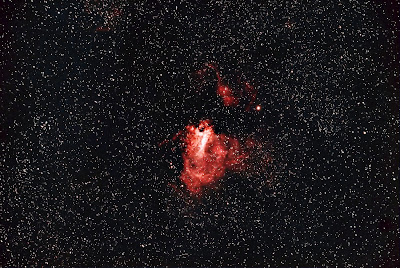This is a stack of 9 x 1 min. taken on 8.8.13, from Bessacarr by Bill Hughes, under Sodium Vapour street lights. The camera was set at ISO 1600, with a 50mm. F2.8 and an LPR filter.
See if you can pick out the nebulous areas, the largest and brightest is the North American Nebula, NGC7000, near the middle left with the Butterfly, NGC1813d, lower to the right.
Another by Bill Hughes from the same location and using the same camera with the gain set at ISO1600. The same street lights were doing their best to spoil things too. The lens fitted for this was a 14mm f2.8, so drawing in a much larger area of sky. The exposure was 10x1min. Again see what features you can recognise.
In both cases the processing was done in Deep Sky Stacker followed by Photoshop.





